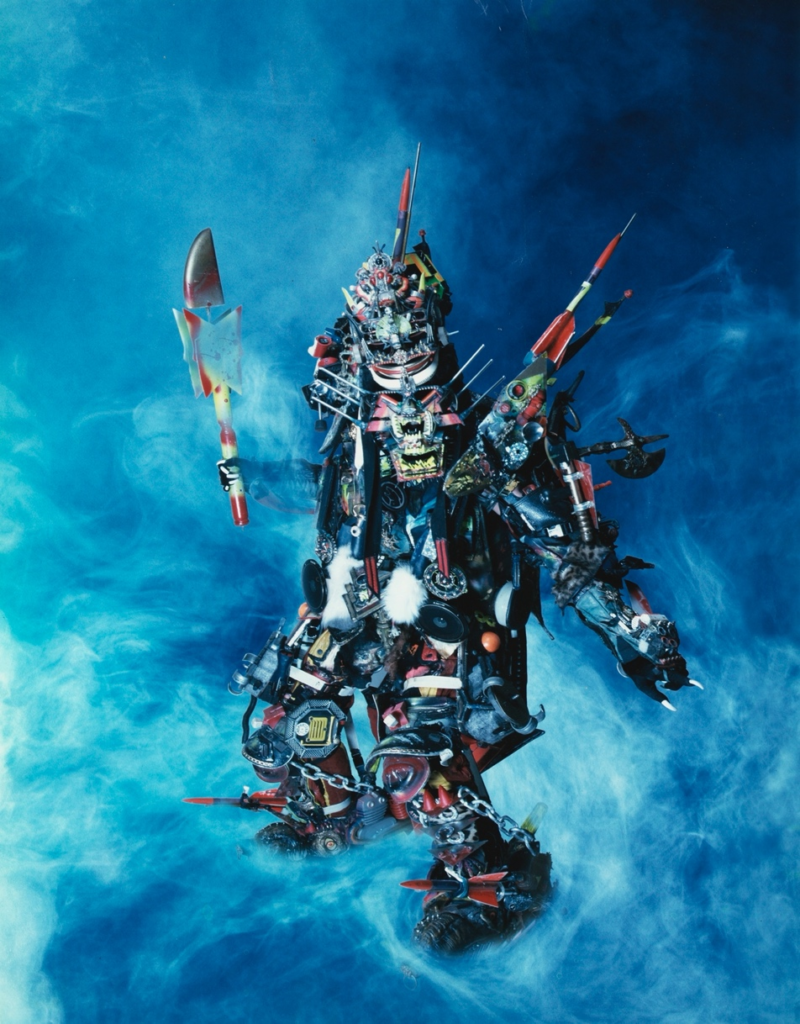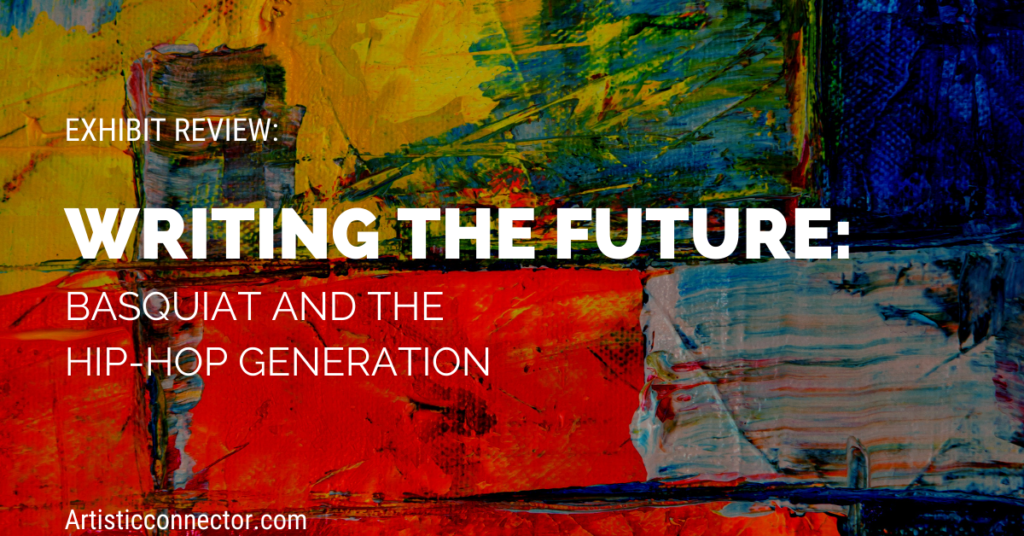The Museum of Fine Arts in Boston has a recent history of opening exhibits that push the envelope past what you might expect of the MFA. The Gender-Bending Fashion exhibit a few years ago was an example of this and this year’s Writing the Future: Basquiat and the Hip-Hop Generation is another. The museum planned to open this exhibit in March 2020, but it was not to be with Covid-19, so it was delayed until 2021. After rave reviews, it was extended until July 25th. And the exhibit is absolutely fantastic. As Murray Whyte of the Boston Globe says, “it already feels like the most important exhibition on Basquiat you’ll ever see, and he’s just one artist among the show’s dozen. 1” The exhibit features 125 pieces by twelve artists, including Basquiat. 120 of those pieces were international loans. Oftentimes, Basquiat is exhibited by himself and out of context: “It is the first major exhibition to contextualize Basquiat’s work in relation to hip-hop and marks the first time his extensive, robust, and reflective portraiture of his Black and Latinx friends and fellow artists has been given prominence in scholarship on his oeuvre. 2“

The Artists
Jean- Michel Basquiat was born in New York City to a Haitian father and Puerto Rican mother. His death in 1988 at the age of 27, a year after the death of his friend and mentor Andy Warhol, has ensured that there will always be a sense of tragedy to his art. It’s hard to not view the angry, crossed-out words on his canvases through the lens that he would eventually overdose and die. Most exhibits try to harness the tragedy and focus on that. His pieces are usually displayed without context, as mentioned before, which only shines a stark spotlight on his perceived troubled life and early death. But with context, you see the vibrancy of the community in which he lived. He was part of a large artistic network that was emerging out of the ashes of a bankrupt and abandoned New York City. Graffiti was the primary medium for many in this network and Basquiat started with graffiti, as well. He was part of a duo, SAMO, and created many of his best-known symbols, like his crown, during that time. His art then and later revolved around social issues; he tried to disassemble power structures with words and symbols. He moved to canvas and his work started getting attention quickly: “At 21, Basquiat became the youngest artist to ever take part in Documenta in Kassel. At 22, he was the youngest to exhibit at the Whitney Biennial in New York. 3” He paved the way for other artists in his community to leave the 3 am graffiti session on a subway car behind and start exhibiting in galleries. In the last article, we talked about high art prices and “at a Sotheby’s auction in May 2017, Untitled, a 1982 painting by Basquiat depicting a black skull with red and yellow rivulets, sold for $110.5 million, becoming one of the most expensive paintings ever purchased. It also set a new record high for an American artist at auction. 4“
Several of those other artists are on display at Writing the Future. Each has its own fascinating story; Rammellzee was an artist, DJ, rapper, and filmmaker; Lady Pink is known as the “first lady of graffiti” and her art shines a light on injustice, particularly in Latin America, with a particularly feminine gaze; Keith Haring is another oftentimes seen tragic artist who died of AIDS in 1990 but gave the world a unique iconography that is still ubiquitous today. Other people in the community are mentioned in the exhibit: Glenn O’Brien, artist, and creator of TV Party, a public access show that covered artists, their art, and what was cool in the 1980s; Madonna; and Debbie Harry of Blondie. New York at this time was a huge artist colony and Basquiat was a part of it. The Fun Fridge on display in the exhibit shows how interlinked everyone was. The fridge, from New York’s Fun Gallery, is covered in signatures and doodles from every artist in the exhibit plus many more.
Exhibit Review
I have been to Writing the Future twice and I think it’s one of the most daring and interesting exhibits the Museum of Fine Arts (MFA) has put on in recent memory. It is the first exhibit to really show how Basquiat was related to and involved in the genesis of hip-hop culture. The music that floods the exhibit space is loud and 80s pop and hip-hop, which gives the feeling of a party rather than a reverential space. Debbie Harry raps in a video shown on a huge screen next to a giant spray-painted portrait of herself by Lee Quiñones. It’s a fun exhibit that immerses the visitor into a youthful, fun movement. But there is an undercurrent to the exhibit as well. The artists were members of the LGBTQ community and/or they were people of color. They were making bold statements about the injustice of the past, the injustice of the present, and the hope or fear they had for the future. Several pieces in the exhibit discuss police brutality, miscarriage of justice, and the effects of war.
The best part of the exhibit, in my opinion, is the last room before the exit. In it are a wearable Samurai suit, entitled Gash-O-Lear made by Rammellzee, a mirror pyramid with his remains, and Basquiat’s Famous Moon King. The room is dark and the samurai suit is in the center lit by black lights to highlight the neon colors. The pyramid is behind, bathed in red light and glowing. And then Basquiat’s painting is besides a dark antithesis to the bright colors and reflections elsewhere in the room. You can stare at this painting for hours and you will continually find new elements in it.

Gash-o-lear, 1989–98, mixed-media sculpture with wireless sound system, keyboard gun, pyrotechnic jawbreaker, and missile launcher, approx. 7′. courtesy the Suzanne Geiss company, new york
Writing the Future is a great exhibit and I highly recommend it. It’s also a signal that the MFA is continuing to put on brave, innovative, and edgier shows. I look forward to what they’ll come up with next.
Have you been to the MFA’s Writing the Future: Basquiat and the Hip-Hop Generation? What did you think of it?
- Murray Whyte Globe Staff et al., “MFA’s Big Basquiat Show Testifies to the Hip-Hop Revolution – The Boston Globe,” BostonGlobe.com, accessed July 6, 2021, https://www.bostonglobe.com/2020/10/15/arts/mfas-big-basquiat-show-testifies-hip-hop-revolution/.
- “Writing the Future,” Museum of Fine Arts, Boston, accessed July 6, 2021, https://www.mfa.org/exhibition/writing-the-future.
- “Jean-Michel Basquiat,” in Wikipedia, July 6, 2021, https://en.wikipedia.org/w/index.php?title=Jean-Michel_Basquiat&oldid=1032216323.
- Ibad

